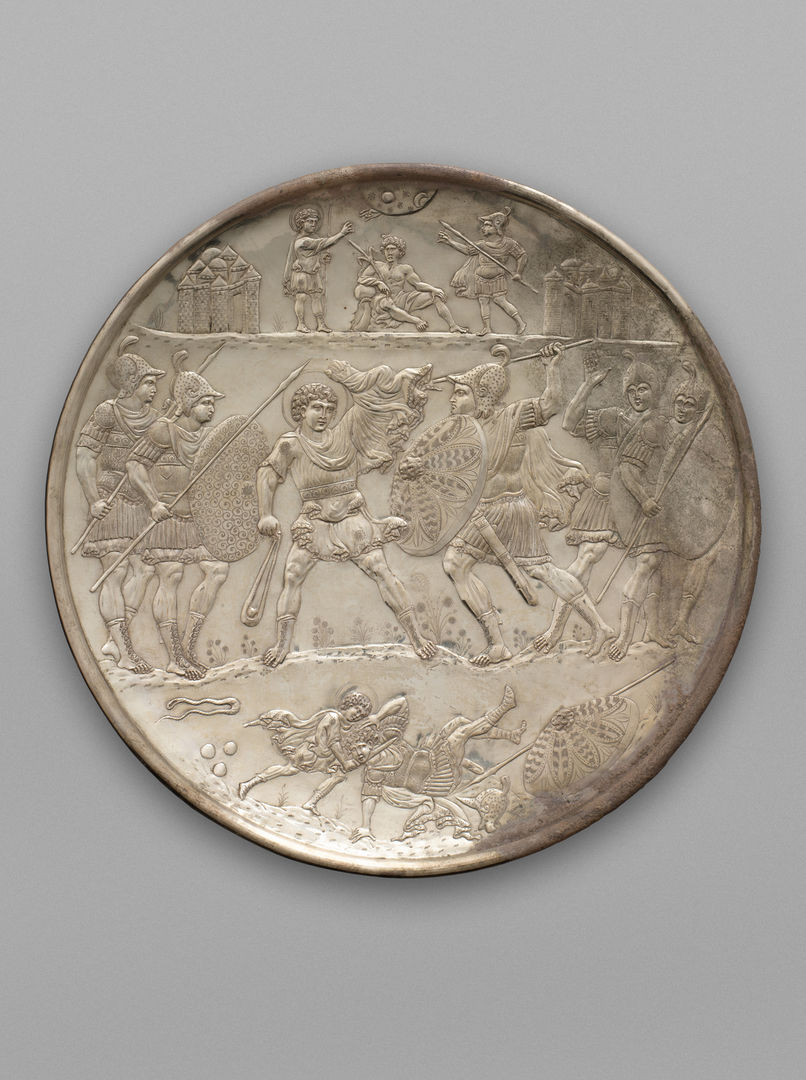The Battle of David and Goliath

Silver Plate with David and Goliath, 629–30. Byzantine, made in Constantinople. Silver, overall: 19 7/16 x 2 5/8 in. (49.4 x 6.6 cm). The Metropolitan Museum of Art, New York, Gift of J. Pierpont Morgan, 1917 (17.190.396)
Collection Areas: European Art, Medieval
Subject Areas: English Language Arts, Visual Arts, World History
Grades: Middle School, High School
Topic/Theme: Power and Leadership, Identity, Stories in Art
Goals
Students will be able to:
- identify strategies artists use to illustrate narratives; and
- use composition and details to convey a story through images.
National Learning Standards
English Language Arts
NL-ENG.K-12.3 Evaluation Strategies
Visual Arts
NA-VA.K-12.1 Understanding and Applying Media, Techniques, and Processes
NA-VA.K-12.2 Using Knowledge of Structures and Functions
NA-VA.K-12.3 Choosing and Evaluating a Range of Subject Matter, Symbols, and Ideas
NA-VA.K-12.4 Understanding the Visual Arts in Relation to History and Cultures
World History
NSS-WH.5-12.4 Era 4: Expanding Zones of Exchange and Encounter, 300–1000 c.e.
Common Core State Standards
English Language Arts
CCSS.ELA-Literacy.CCRA.R.7 Integrate and evaluate content presented in diverse media and formats, including visually and quantitatively, as well as in words.
CCSS.ELA-Literacy.CCRA.SL.1 Prepare for and participate effectively in a range of conversations and collaborations with diverse partners, building on others' ideas and expressing their own clearly and persuasively.
Questions for Viewing
- What do you notice about the material used to create this object? Why do you think the artist selected it?
- Who might have owned an object like this? What might it have been used for?
- What appears to be happening in the central scene?
- Who would you identify as the main characters? Why?
- What type of clothing and accessories are these figures wearing? What might this indicate?
- What do you notice about the organization of the image?
- What appears to be happening in the scene at the top and bottom? How do the scenes relate to one another?
- What strategies has the artist used to help us identify the characters in the top section as David and Goliath?
- What do you notice about the gestures and facial expressions of these figures? What might this tell us?
- How does the artist indicate that time is passing in the narrative?
Activity
Activity Setting: Classroom
Materials: Drawing paper, pens, pencils, markers, and paint
Subject Areas: English Language Arts, Visual Arts
Duration: 60 minutes
Choose a well-known secular or religious narrative from books or television and consider the key figures and events. Draw, paint, or use a computer to create a poster, without words, that reflects the story. Utilize pose and accessories to convey information about each figure and use the David Plates as a source of inspiration for organizing the various scenes into a unified composition. Share your completed work to see how others interpret the image.
Resources
De Capoa, Chiara. Old Testament Figures in Art. Los Angeles: J. Paul Getty Museum, 2003.
Morales, Esther M., Michael B. Norris, Alice W. Schwarz, and Edith W. Watts. A Masterwork of Byzantine Art: The David Plates—The Story of David and Goliath. New York: The Metropolitan Museum of Art, 2001. Download the resource.
Norris, Michael. Medieval Art: A Resource for Educators. Also available in print; New York: The Metropolitan Museum of Art, 2005. Download the resource.
Pre-Visit Guide for Teachers: The Art of Medieval Europe (PDF)
"Silver Plate with David and Goliath [Byzantine] (17.190.396)." In Heilbrunn Timeline of Art History. New York: The Metropolitan Museum of Art, 2000–. (October 2006 (Entry includes a number of additional resources.)
Objects in the Museum's Collection Related to this Lesson
Plate with the Presentation of David to Saul, 629–30. Byzantine, made in Constantinople. Silver; overall: 10 11/16 x 1 9/16 in. (27.2 x 4 cm). The Metropolitan Museum of Art, New York, Gift of J. Pierpont Morgan, 1917 (17.190.397)
Marco del Buono Giamberti (Italian, Florentine, 1402–1489) and Apollonio di Giovanni di Tomaso (Italian, Florentine, 1415/17–1465), The Story of Esther, 1460–70. Tempera and gold on wood, 17 1/2 x 55 3/8 in. (44.5 x 140.7 cm). The Metropolitan Museum of Art, New York, Rogers Fund, 1918 (18.117.2)
Author: Adapted from A Masterwork of Byzantine Art: The David Plates—The Story of David and Goliath, The Metropolitan Museum of Art, 2001